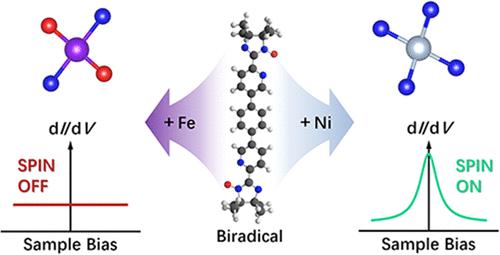当前位置:
X-MOL 学术
›
J. Am. Chem. Soc.
›
论文详情
Our official English website, www.x-mol.net, welcomes your
feedback! (Note: you will need to create a separate account there.)
Spin Manipulation of Single Nitroxide Radical on Au(111) by Selective Coordination
Journal of the American Chemical Society ( IF 14.4 ) Pub Date : 2025-06-04 , DOI: 10.1021/jacs.5c00342
Yansong Wang, Xin Li, Meng-Xiang Wu, Jie Li, Xueyan Wang, Wenjie Dong, Ziyong Shen, Yang He, Yajie Zhang, Xueliang Shi, Hai-Bo Yang, Shimin Hou, Kai Wu, Song Gao, Yongfeng Wang
Journal of the American Chemical Society ( IF 14.4 ) Pub Date : 2025-06-04 , DOI: 10.1021/jacs.5c00342
Yansong Wang, Xin Li, Meng-Xiang Wu, Jie Li, Xueyan Wang, Wenjie Dong, Ziyong Shen, Yang He, Yajie Zhang, Xueliang Shi, Hai-Bo Yang, Shimin Hou, Kai Wu, Song Gao, Yongfeng Wang

|
Organic radicals are promising candidates for constructing molecule-based magnetic materials. Despite the achievements of various radical ligand-containing complex materials, tuning the spin state of organic radicals at the single-molecule level on surfaces remains a challenge. In this study, the spin state of the DPBIN molecule, a derivative of 1,4-di(pyridine-3-yl)benzene bearing two imino-nitroxide radicals in para positions, is tuned by selective coordination with Au, Ni, and Fe centers on the Au(111) surface. The DPBIN molecules provide nitroxide oxygen atoms as ligand atoms in the Au and Fe coordination structures, where the spin of the DPBIN molecules is quenched. By contrast, the nitroxide oxygen atoms are not involved in coordination with Ni atoms; thus, the spin is preserved in this structure. Scanning tunneling microscopy (STM) and spectroscopy (STS) are employed to characterize the geometric structures and spin states of these coordination structures at the atomic level. Interestingly, this spin-manipulation method demonstrates a broader applicability to other metal coordination systems. This research deepens our understanding of the effect of selective coordination on radical spins.
中文翻译:

通过选择性配位对 Au(111) 上单个一氧化二自由基的自旋作
有机自由基是构建分子基磁性材料的有前途的候选者。尽管各种含有自由基配体的复杂材料取得了成就,但在表面的单分子水平上调整有机自由基的自旋状态仍然是一个挑战。在本研究中,DPBIN 分子的自旋态是 1,4-二(吡啶-3-基)苯的衍生物,在对位带有两个亚氨基-硝基自由基,通过与 Au(111) 表面上的 Au、Ni 和 Fe 中心选择性配位来调节。DPBIN 分子在 Au 和 Fe 配位结构中提供氮氧化物氧原子作为配体原子,其中 DPBIN 分子的自旋被淬灭。相比之下,氮氧化物氧原子不参与与 Ni 原子的配位;因此,自旋保留在此结构中。扫描隧道显微镜 (STM) 和光谱学 (STS) 用于在原子水平上表征这些配位结构的几何结构和自旋态。有趣的是,这种自旋纵方法证明了对其他金属配位系统的更广泛适用性。这项研究加深了我们对选择性配位对自由基自旋影响的理解。
更新日期:2025-06-04
中文翻译:

通过选择性配位对 Au(111) 上单个一氧化二自由基的自旋作
有机自由基是构建分子基磁性材料的有前途的候选者。尽管各种含有自由基配体的复杂材料取得了成就,但在表面的单分子水平上调整有机自由基的自旋状态仍然是一个挑战。在本研究中,DPBIN 分子的自旋态是 1,4-二(吡啶-3-基)苯的衍生物,在对位带有两个亚氨基-硝基自由基,通过与 Au(111) 表面上的 Au、Ni 和 Fe 中心选择性配位来调节。DPBIN 分子在 Au 和 Fe 配位结构中提供氮氧化物氧原子作为配体原子,其中 DPBIN 分子的自旋被淬灭。相比之下,氮氧化物氧原子不参与与 Ni 原子的配位;因此,自旋保留在此结构中。扫描隧道显微镜 (STM) 和光谱学 (STS) 用于在原子水平上表征这些配位结构的几何结构和自旋态。有趣的是,这种自旋纵方法证明了对其他金属配位系统的更广泛适用性。这项研究加深了我们对选择性配位对自由基自旋影响的理解。


















































 京公网安备 11010802027423号
京公网安备 11010802027423号